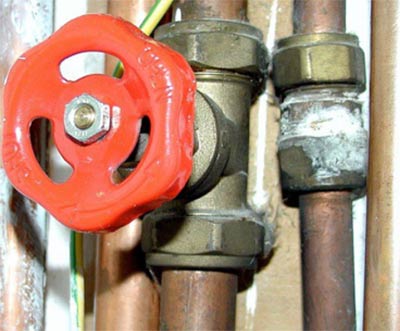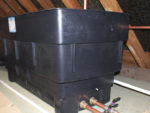This section is all about the water systems that are commonly found in a domestic setting. It is likely that you home will have either a direct or indirect cold water system; we explain the differences between these and how they work.
We help you to find leak and how to deal with commons problems that will affect your system, such as hard water. There is also information about how tanks and cisterns work so that you can ensure that they are installed and maintained properly.
Information about the pipes and pipe work can be found in a different section, where we cover all the techniques and guidance for completing and maintaining the pipes in your water system.
We have a separate section all about Taps and Valves which will be useful if you are working on your water system. You can find all the information we have on taps and valves here. In fact there is a whole section all about every aspect of plumbing that you can imagine, so it is worth browsing our Plumbing Section here.
The Basics about Domestic Water Systems
There are two parts to your domestic water system:
- The first part brings in clean water.
- The second takes away the waste water.
The water that comes into your homes will generally come from the mains, which will be drinkable (potable) water and under pressure. The pressure should be enough to get the water around your house, even up stairs. This is the responsibility of the water company to ensure the pressure is correct; too low and you will not get enough water for some appliance to work (such as showers for example) and too high it may damage appliances in your home.
For more information about water pressure you will find a great article by Ofwat, the water regulator, which explains what is and why pressure is important. They also explain what you should do if you feel that the water pressure is not correct.
Top Tip: If the mains pressure is low, check to see if your stop-cock is completely open (see below for more details). A partially closed stop cock will reduce the flow into your home.
The used or waste water is removed in the waste water part of the system, which we cover in much more detail in the Waste Water Section. This is generally removed by gravity and taken away for treatment by the local water company through the sewerage system.
If the waste water cannot be removed by the local water company, there are a number of options:
- Cesspits and Cesspools; This is where all the waste water (and solids) sits until it can be collected by a “honey sucker” tanker lorry and taken away for treatment. This is a very expensive option and generally the last resort as it will need to be emptied regularly
- Septic Tank; This is similar to a cesspit except only the solids settle and are collected while the liquid effluent is allowed to soak away. Over 60% of housing sites in the UK will not be allowed to use this and there are strict rules enforced by the Environment Agency
- Sewage Treatment Plants; there are a range of solutions that will treat the waste from your home in individual treatment plans. They use mechanical methods such as rotating paddles or injected air and bacteria to digest the waste. Research is key to understand which type of system is right for your situation
The Direct and Indirect Water Systems – How to Tell which Type of Water System You Have
There are several types of water systems. At the most basic, they are either direct or indirect. This is an important distinction if you need to turn the water off, particularly in an emergency, as you will see below.
With Direct water systems the water is fed into your home directly from the mains. An indirect system will be fed by a tank, which is typically situated in the loft to provide the necessary head for pressure. The mains fill the tank and then the water is distributed around the house by gravity from the tank.
There are several types of indirect water systems, which are largely determined by how the boiler is incorporated into the system. We cover these in greater detail in our page all about Central Heating Systems. In this section you will find projects which cover each type in detail to help with repairs and maintenance.
How to Turn Off the Water Using a Stopcock
If you have a plumbing disaster you then might need to turn off the water to stop water flooding your home. Ideally you will have isolation valves before every appliance so that these can be turned off individually isolating where the leak is coming from but sometimes you will not be quite so lucky.
Where the water enters your home, generally under the kitchen sink in many homes, there might be a large tap which can be turned off to stop all the water coming into the house.

Every home should have one of these, even if it is old and jammed. They can be lever taps or taps fitted near the water meter. It is worth finding it and testing it before you have an emergency. Spray a little WD40 on to it from time to time to keep it serviceable.
There might not be a stopcock, or at least one that you can find in your home. If this is the case, look outside on the street where there should be a small Access Cover, generally marked with “Water” or a “W” which you should be able to lift or prize open (use a sturdy old flat head screw driver). Inside will be your meter and a stopcock. It might be encased in polystyrene insulation (to stop it freezing).

If you are turning off a stopcock outside, make sure that it is for your house! It can be difficult to tell which is for which home when there are a number close to each other on the street, particularly if the house has been split into flats for example. Don’t risk potentially damaging an appliance in a neighbour’s home by turning off their water mid-flow.
You can work which is your meter and stopcock by checking the readings of all the likely meters, and seeing how quickly that are incrementing. Then go inside and turn a tap on full flow. Now when you go and look at the meters again, yours will be the one that has started to turn over or increment faster. When you turn off the stopcock, check that the tap inside has stops; if it has not you have got the wrong one – Note this will only be the case for a direct system so see below for turn off the water in an indirect system.
Turning off the stopcock might need a special key, which might be kept in the meter casing or hole. It’s worth know this and where the key is before you have an emergency.

How to Turn off the Water if You Have an Indirect Water System
Turning off the stopcock will only have an immediate effect if you have a direct water system, as the water come directly from the mains, through your open stopcock, and to your taps.
For an indirect system the water from the mains is collected and held in a storage tank so turning off the mains water stopcock will only stop the tank being refilled. The water will keep being supplied from the tank until it is emptied, which could be quite some time!
Remember that you will have a cold storage and a hot water storage tank which can continue to supply water. These need to either be drained safely by running them dry or ideally isolating them – turning off the tap in the main pipe from them to the rest of the house.
There should be gate (tap) under the tanks which can be turned off to stop the water flowing from the tank. This will be under the tank, generally in the attic.

It is important to know which type of water system that you have so that you know what to do to turn off the water when you need to. It’s well worth testing this, before you have an emergency as then you will know exactly where to find the right taps valves and stopcock, and how to turn them off.








